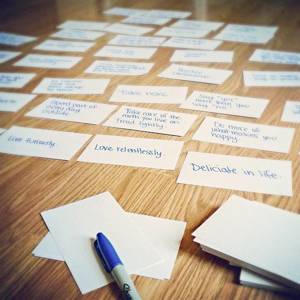What matters most to you? What do you believe in? What does your ideal life look like?
I spent a long time thinking about these questions and deciding how exactly I wanted my life to look. I literally spent months crafting my manifesto – putting it aside for a bit and then coming back to it, adding to it and refining it – until I felt like it was the best representation of my values, ideals, and goals. And when it came time for me to figure out how I was going to actually put it into practice – that’s when I came up with the idea for this blog. It’s what inspired me to create and commit to Project Delici8.
My manifesto is at the very core of all of this. That’s why I’ve spent so much time writing about this subject over the past couple of weeks. And that’s why I think there’s so much value to creating a personal manifesto of your own. I’ve experienced it for myself and I believe in it.
If you haven’t already read it, I just wrote a list of 10 reasons why you should write a personal manifesto of your own. I hope I’ve at least made you think about the idea of putting one together for yourself.
And here’s the thing. If you think a manifesto is not for you because you live a simple, unassuming life or you don’t have a lot of grand aspirations, don’t let that stop you. A manifesto doesn’t have to be a lofty or overly ambitious statement chock full of a bunch of grandiose life goals. It doesn’t have to be about travel and career and moving up in the world. It can be about spending more quality time with your partner, making it a priority to read to your kids every day, and finding the time to sit down to a technology-free family dinner on a regular basis. It can be about making an effort to drive less and recycle more, or to eat more vegetables and less meat. It can be about making it a goal to get outside more often, even if it’s just to the park down the street. Or it can be about the virtues you’d like to cultivate – such as being more honest, more grateful, more generous, or more kind.
You can look at your life as a whole, like I did, or you can focus on one specific aspect of your life, like maybe your health, your relationships with others, or your career or business goals. A manifesto can be about anything that you feel strongly about, as long as it’s a bold declaration of intentions. The rest is up to you.
There are no rules as to how you should write your manifesto. Write it in first person if you like, or in second person. Use present tense or use future tense. Write in short phrases or complete paragraphs. Maybe your manifesto will take the shape of a bulleted list, or maybe it will be more like a letter you write to yourself or someone else. There is no right or wrong way to do it. Just do what comes most naturally to you.
So just how do you write a personal manifesto? I’ve broken it down for you into five simple steps.
Step 1. Check out other manifestos for a bit of inspiration. There are so many manifestos out there. You’ve probably already seen a ton of them. I’ve already put together two posts in which I compiled a bunch of inspiring or influential manifestos. They span a wide range of formats and were created by a very diverse group of people and organizations – everything from modern writers and bloggers to big corporations such as Apple, Google, and Lululemon to famous names like Audrey Hepburn, Benjamin Franklin, and Frank Lloyd Wright. Check those out first:
8 Thought-Provoking Manifestos to Inspire You
8 More Amazing Manifestos That Will Make You Think
Which ones resonate with you most? What ideas and principles do you wholeheartedly agree with? Draw from others’ ideas and works for inspiration.
Step 2. Ask yourself the following questions and take notes on your answers:
- What do you believe in at your core? What are your deepest-rooted values and ideals?
- How do you define yourself? What do you stand for?
- What inspires and motivates you?
- What do you know to be true? What quotes do you love? What “words of wisdom” really speak to you?
- What breaks your heart? What bothers you?
- Where do you want to spend your money?
- How do you want to spend your time?
- How do you want to interact with others on a daily basis?
- What does good health mean to you and how will you achieve it?
- What are your biggest dreams and goals in life?
- How to you want to change the world? What effect would you like your life to have on those around you?
- How will you deal with failures, mistakes, or disappointments? How will you react when times get tough and you’re faced with hardships?
- How do you define success? How do you define happiness?
- What changes do you need to make in order to live a life truly worth living?
Step 3. Use what you’ve written to start putting together a rough draft of your manifesto. Figure out what format you’d like your manifesto to take, then start putting it together. Look at the notes you’ve taken and start by drawing from the ideas and concepts that have come up most often. Focus on what really jumps out at you. Expand on the things that really excite you. Don’t worry about editing for now, just get your ideas down – all of them.
 Step 4. Set your manifesto aside for a bit, then come back to it. Start to edit and refine what you’ve written. Highlight what you feel most strongly about. Cross out what’s unnecessary. Move things around and edit, edit, edit – until you have a finished product that truly represents you and your ideas.
Step 4. Set your manifesto aside for a bit, then come back to it. Start to edit and refine what you’ve written. Highlight what you feel most strongly about. Cross out what’s unnecessary. Move things around and edit, edit, edit – until you have a finished product that truly represents you and your ideas.
Again, do what works for you. Once I got to this step, I wrote down each one of my principles on a separate note card. Then I laid them all out on the floor and started arranging and editing and rearranging them until I had something that flowed well when read as a whole.
Step 5. Finalize your manifesto. Print it out or publish it. Then challenge yourself to actually live it. Make it public or at least print it out and put it somewhere visible – someplace where you can come back to it often, if not daily. This helps keep you accountable to what you’ve written.
Then challenge yourself to live your manifesto. Don’t let it overwhelm you – that’s not the point. Don’t expect that you will be able to live every aspect of your manifesto every day. But pick one or two things to focus on each day or week or month. Let it inspire you and let it challenge you.
And don’t forget to share! If you have a personal manifesto, I’d love to see it. And check out my manifesto (and how I’m living it) here!

